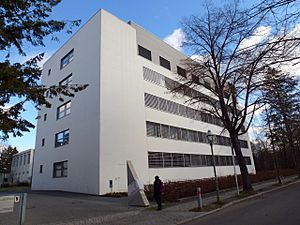Fritz Haber Institute of the Max Planck Society facts for kids
The Fritz Haber Institute of the Max Planck Society (FHI) is a special science research center. It is located in Dahlem, a part of Berlin, Germany. Scientists here study many different things, especially in chemistry and physics.
The institute started in 1911 as the Kaiser Wilhelm Institute. In 1953, it became part of the Max Planck Society. It was also renamed after its first director, Fritz Haber.
Over the years, scientists at the FHI have studied many exciting topics. These include how chemicals react, how tiny particles behave, and how surfaces work. They also explore the physics of atoms and molecules. During World War I and World War II, some of the institute's research was used to help Germany's needs.
Many famous scientists have worked at the FHI. Several of them even won the Nobel Prize for their amazing discoveries. These include Fritz Haber (1918), Max von Laue (1914), James Franck (1925), Otto Hahn (1944), Eugene Wigner (1963), Ernst Ruska (1986), and Gerhard Ertl (2007).
Contents
What Scientists Study Here
Scientists at the Fritz Haber Institute explore many different areas of science. They try to understand how materials work at a very tiny level. This helps us create new technologies and solve important problems.
Inorganic Chemistry
This department studies materials that do not contain carbon, like metals and minerals. They look at how these materials react and what their electronic structure is like. They also study what happens at the surface where liquids and gases meet.
- Reactivity: How different substances react with each other.
- Electronic Structure: How electrons are arranged in materials.
- Liquid/vapor Interfaces: What happens where liquids and gases touch.
- Electron Microscopy: Using powerful microscopes to see tiny details.
Interface Science
This group focuses on the surfaces of materials. They want to know how atoms and molecules behave on these surfaces. This is important for things like making new catalysts or better electronic devices.
- Liquid Phase Electron Microscopy: Studying materials in liquid using special microscopes.
- Scanning Probe Microscopy: Using tiny probes to map surfaces.
- Thin Films: Studying very thin layers of materials.
- Structure and Reactivity: How the shape of a surface affects its reactions.
Molecular Physics
Scientists in this department study molecules and how they interact. They use special tools to control molecules and see how they behave. This helps us understand the basic rules of nature.
- Controlled Molecules: Guiding molecules with electric or magnetic fields.
- Spectroscopy and chemistry of metal clusters: Studying groups of metal atoms and their reactions.
- Interactions of molecules with fields: How molecules react to different forces.
- Cold and ultracold molecules: Studying molecules at very low temperatures.
Physical Chemistry
This department looks at the physical properties of chemical systems. They often use very fast lasers to watch reactions happen in real-time. They study how energy moves through materials and how surfaces change.
- Nanoscale Surface Chemistry: Chemistry on extremely tiny surfaces.
- Ultrafast Scanning Probe Microscopy: Using fast methods to study surfaces.
- Lattice Dynamics: How atoms vibrate in a solid material.
- Nonlinear Interfacial Spectroscopy: Using light to study surfaces.
- Terahertz Physics: Studying materials with special kinds of light waves.
Theory
The theory department uses computers and math to understand chemical and physical processes. They create models and simulations to predict how materials will behave. This helps guide experiments and discover new things.
- Data-Efficient Chemical Machine Learning: Using computers to learn about chemistry from data.
- Multiscale Modeling: Creating computer models that work for different sizes, from tiny atoms to large reactors.
- First-principles modeling: Using basic laws of physics to understand how materials work.
- Interatomic machine learning potentials: Using AI to predict how atoms interact.
See also
 In Spanish: Instituto Fritz Haber de la Sociedad Max Planck para niños
In Spanish: Instituto Fritz Haber de la Sociedad Max Planck para niños


